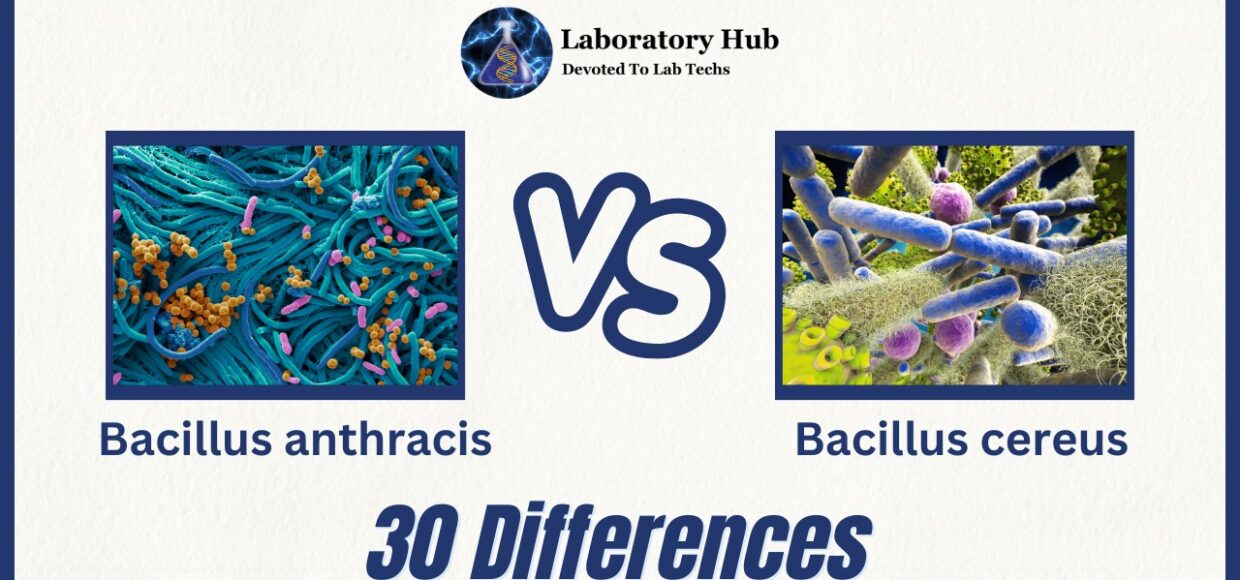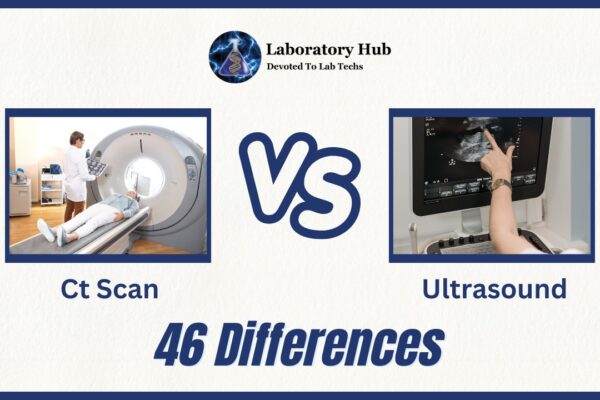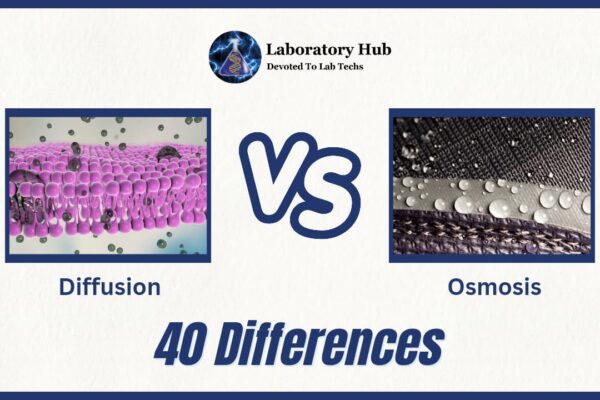Bacillus anthracis vs Bacillus cereus – 30 Differences
Rod-shaped and endospore-forming, these species are similar. They differ in pathogenicity, ecological niche, and clinical importance. Understanding these characteristics helps identify, diagnose, and treat certain bacteria-related illnesses.
Bacillus anthracis, which causes anthrax, is a dangerous disease. Infected herbivorous animals or animal products can spread it to humans. Anthrax infections can be cutaneous, inhalational, or gastrointestinal. The latter two are the most dangerous. B. anthracis produces pathogenic toxins thanks to pXO1, a unique plasmid.
Bacillus cereus is an opportunistic human pathogen. It is prevalent in soil, dust, and food. Food poisoning from B. cereus is common. Bacteria create toxins that cause diarrheal and emetic food poisoning. B. cereus infections are usually self-limiting and less severe than anthrax, although they can still provide substantial pain and danger to people with weaker immune systems.
Other than their clinical effects, B. anthracis and B. cereus vary. First, B. anthracis is an obligatory pathogen, while B. cereus is an opportunistic pathogen. Second, B. anthracis affects herbivores and humans, but B. cereus may infect a wider range of species. B. anthracis, unlike B. cereus, has a poly-D-glutamic acid capsule that helps it avoid the host immunological response.
Antibiotic susceptibility differs across species. B. anthracis responds well to medications including penicillin, doxycycline, and ciprofloxacin, however, B. cereus may require antibiotic sensitivity testing for therapy. B. cereus is not a bioterrorism agent, but B. anthracis is. In conclusion, Bacillus anthracis and Bacillus cereus are separate bacterial species with some similarities but considerable variations in pathogenicity, clinical effect, host range, antibiotic susceptibility, and classification. Understanding these variations helps diagnose, treat, and prevent certain bacteria-related diseases. Exploring their distinct traits will improve medical research, public health, and biodefense.
S.No. | Category | Bacillus anthracis | Bacillus cereus |
1 | Disease Association | Causes anthrax, a severe and potentially fatal disease in humans and animals. | Can cause food poisoning and other localized infections in humans. |
2 | Virulence Factors | Produces anthrax toxins: protective antigen, edema factor, and lethal factor. | Produces various toxins, including enterotoxins and hemolysins. |
3 | Spore Formation | Forms spores under unfavorable conditions for survival. | Forms spores under unfavorable conditions for survival. |
4 | Spore Location | Spores are centrally located within the bacterial cell. | Spores are located subterminally within the bacterial cell. |
5 | Spore Resistance | Spores are highly resistant to environmental stresses, such as heat and chemicals. | Spores are highly resistant to environmental stresses, such as heat and chemicals. |
6 | Transmission | Typically transmitted through contact with contaminated animals or their products. | Can be transmitted through contaminated food, water, or contact with infected individuals. |
7 | Capsule | Possesses a poly-D-glutamic acid capsule, which is an important virulence factor. | May or may not possess a capsule depending on the strain. |
8 | Morphology | Rod-shaped bacteria with chains or pairs arrangement. | Rod-shaped bacteria with chains or pairs arrangement. |
9 | Hemolysis | Non-hemolytic (does not cause blood cell lysis). | Beta-hemolytic (causes complete blood cell lysis). |
10 | Motility | Non-motile (lacks flagella). | Motile (possesses peritrichous flagella). |
11 | Growth Temperature | Grows optimally at 37°C (body temperature). | Grows optimally at 30-37°C (room temperature to body temperature). |
12 | Pathogenicity Islands | Contains a pathogenicity island called pXO1, which encodes anthrax toxins. | Contains various pathogenicity islands associated with different virulence factors. |
13 | Animal Hosts | Infects a wide range of mammals, including humans, livestock, and wildlife. | Can cause infections in a variety of animals, including insects, birds, and mammals. |
14 | Reservoirs | Found in soil and contaminated animal products, such as wool and hides. | Found in soil, dust, and various food sources, including rice, pasta, and vegetables. |
15 | Diagnosis | Diagnosis often requires laboratory tests, including culture and molecular methods. | Diagnosis often requires laboratory tests, including culture and molecular methods. |
16 | Vaccine Availability | Vaccines are available for prevention in humans and livestock. | No specific vaccines available for human use; some vaccines for livestock are available. |
17 | Antibiotic Susceptibility | Generally susceptible to antibiotics, such as penicillin and ciprofloxacin. | Antibiotic susceptibility can vary among different strains. |
18 | Resistance to Desiccation | Spores can resist desiccation and remain viable for long periods. | Spores can resist desiccation and remain viable for long periods. |
19 | Toxin Production | Produces lethal toxins that damage host tissues and immune response. | Produces toxins that can cause gastrointestinal symptoms and other localized effects. |
20 | Zoonotic Potential | Can be transmitted from animals to humans (zoonotic disease). | Can be transmitted from animals to humans (zoonotic disease). |
21 | Genetic Variation | Limited genetic variation due to clonal reproduction. | Exhibits genetic diversity and can be grouped into different clades. |
22 | Biochemical Reactions | Can exhibit specific biochemical reactions used for identification. | Can exhibit specific biochemical reactions used for identification. |
23 | Resistant to Gamma Phage | Sensitive to gamma phage. | Resistant to gamma phage. |
24 | Pathogenesis | Pathogenesis involves the production of toxins that disrupt host immune responses. | Pathogenesis involves the production of toxins and enzymes that contribute to tissue damage. |
25 | Treatment | Requires immediate treatment with antibiotics, such as penicillin and doxycycline. | Treatment with antibiotics, such as ciprofloxacin and erythromycin, may be necessary in severe cases. |
26 | Global Distribution | Found worldwide but more common in certain regions with specific environmental conditions. | Found worldwide and can be commonly isolated from various sources. |
27 | Inhalational Anthrax | Inhalational anthrax is the most severe form, with high mortality if untreated. | Does not cause inhalational anthrax but can cause other types of infections. |
28 | Pathogenicity | Highly pathogenic and can cause systemic infections. | Can cause both localized and systemic infections, depending on the strain. |
29 | Endospore Staining | Exhibits characteristic endospore staining. | Exhibits characteristic endospore staining. |
30 | Environmental Persistence | Spores can persist in the environment for long periods, contributing to disease outbreaks. | Spores can persist in the environment for long periods, contributing to contamination and foodborne illness outbreaks. |
Frequently Asked Questions (FAQs)
Clinical effects and pathogenicity distinguish Bacillus anthracis from Bacillus cereus. Anthrax, a deadly illness, is caused by B. anthracis. B. cereus, an opportunistic bacterium that causes food poisoning, is less severe and self-limiting than anthrax.
Bacillus anthracis is spread by direct contact with animals or animal products like meat, skins, and wool. Inhaling spores from contaminated materials or touching diseased animals can cause anthrax. Bacillus cereus is spread through eating infected rice, pasta, and other starchy foods.
Bacillus anthracis infections are cutaneous, inhalational, or gastrointestinal. Inhalational anthrax affects the respiratory system and can be fatal, whereas gastrointestinal anthrax affects the digestive system and is similarly serious. Bacillus cereus infections cause food poisoning, causing stomach discomfort, diarrhea, and vomiting depending on the bacteria’s toxin.
Penicillin, doxycycline, and ciprofloxacin can treat Bacillus anthracis infections, however immediate treatment is necessary owing to the disease’s severity. Bacillus cereus infections, especially food poisoning, frequently resolve without therapy. In extreme instances or in immunocompromised patients, antibiotics may be recommended.
Preventing Bacillus anthracis infections requires animal immunization, appropriate corpse handling and disposal, and laboratory and hospital cleanliness. Good food hygiene—proper storage, cooking, and handling—prevents Bacillus cereus. Preventing Bacillus cereus food poisoning requires temperature control and cross-contamination.







